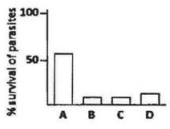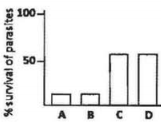 Multiple Choice Questions
Multiple Choice QuestionsThe only bone marrow cell that never appears in peripheral blood is
myeloblast
myelocyte
lymphoblast
Megaloblast
Thyroxin releasing hormone (TRH) receptor belongs to
nuclear receptor family
receptor tyrosin kinase family
G-protein-coupled receptor family
Guanylate cyclase receptor family
One highly pathogenic DNA virus enters into the host cell by endocytosis replicates in the nucleus followed by cell lysis. You have drugs at your followed by cell lysis. You have drugs at your disposal that block
A. acidification of vesicles.
B. mitochondrial transport
C. nuclear export
D. exocytosis.
Identify the right combination to prevent its infection.
A and B
B and D
A and C
A and D
The cell cycle is regulated by various cyclins and cyclin-dependent kinases (CDK). On receiving mitotic stimuli, cyclin D, the first cyclin expressed, binds with existing CDK4 to form the active cyclin D-CDK4 complex. This, in turn, phosphorylates retinoblastoma protein (Rb) which activates E2f to further activate the transcription of various downstream cyclins. In a particular cell type there is a mutation in Rb such that it cannot be phosphorylated. What will be the correct expression pattern of cyclin E in these cells after mitotic stimulation?




Clearance of phagocytosed intracellular parasite like Leishmania requires the involvement of reactive oxygen species (RNS). Administration of IFN-γ to macrophages harbouring an intracellular pathogen leads to the production of ROS and RNS by JAK/STAT pathway. A macrophage cell line J774 infected with Leishmania is given the following treatments.
A. IFN-γ.
B. IFN-γ + AMT, a potent iNOS inhibitor.
C. IFN-γ + apocyanin, a NADPH oxidase inhibitor.
D. IFN-γ + NMMA (N-monomethyl arginine), an arginine analogue.
What will be the most appropriate graph showing the survival of parasites after these treatments.




A ligand recognizes two different cell surface receptors, A and B, on the same cell type. Receptor A, after binding with the ligand is internalized along with the ligand whereas receptor B, after binding with the ligand, initiates tyrosine kinase activity of the intracellular domain. One particular disease is associated with the loss of receptor-mediated signal transduction of the ligand. Different observers inferred that the disease may be resulted due to
A. loss of binding affinity of receptor A due to mutation in the extracellular domain.
B. loss of binding affinity of receptor B due to mutation in the extracellular domain.
C. mutation in the tyrosine kinase domain rendering it inactive.
D. mutation in the intracellular domain rendering it incapable of endocytosis.
Which combination of the above inferences do you think appropriate for the cause of the disease?
A andB
B and C
C and D
A and D
An important role of Fas and Fas ligand is to mediate elimination of tumor cells by killer lymphocytes. In a study of 35 primary lung and colon tumors, half the tumors were found to have amplified and overexpressed a gene for a "secreted protein" that binds to Fas ligand. The main reason for survival of these tumor cells by this "secreted Fas-ligand binding protein" may be attribute to its
decoy receptor activity
anti-proliferative activity
cellular defense activity against immune-cytotoxic killing
anti-contact inhibition activity
A potentially valuable therapeutic approach for killing tumour cells without affecting normal cells is the use of immunotoxins. Immunotoxins consist of particular cell-specific monoclonal antibodies coupled to lethal toxins. Which of the following molecular approaches is NOT appropriate for killing tumor-cells?
Cell surface receptor binding polypeptide chain of toxin molecules should be replaced by monoclonal antibodies which are specific for a particular tumor cell.
Constant region Fc domain of tumor cell-specific monoclonal antibody should be replaced by toxin molecules.
Variable region Fc domain of tumor cell-specific monoclonal antibody.
Inhibitor polypeptide chain of toxin molecules should be conjugated to the F(ab) domain of tumor-specific monoclonal antibody.
Which one of the following is NOT related to immediate hypersensitivity reactions?
Mast cell degranulation results in histamine-mediated allergic reactions.
Reaginic antibodies trigger allergic reactions.
Granulomatous reaction is a key to contain infection.
Anaphylactic reaction is triggered primarily by IgE.
A pathogen like Mycobacterium, which colonizes inside the cells of the host, is likely to be least affected by which one of the following host immune defense mechanisms?
Cell-mediated immune response
CD4+ T lymphocytes
Cytokines
Humoral immune response
